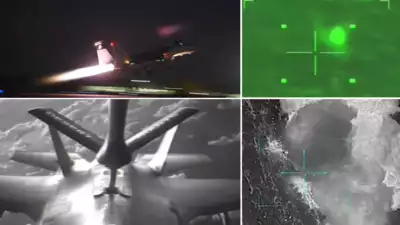Mid-Air Refuel, Precision Strikes
Mid-Air Refuel, Precision Strikes: How the Israeli Air Force Hit HezbollahThe Israeli Air Force (IAF) has long been renowned for its technological prowess and strategic precision. One of its most striking recent demonstrations of these capabilities was the airstrike against Hezbollah positions, which underscored the sophistication of modern military operations. This operation not only involved precise targeting but also showcased the critical role of mid-air refueling in extending the reach and effectiveness of air missions.
Strategic Context
Hezbollah, a Shiite militant group based in Lebanon, has been a persistent adversary to Israel. The ongoing conflict between the two has seen numerous escalations, and the IAF’s operations are a key component of Israel’s defense strategy. The recent strike against Hezbollah was part of a broader effort to neutralize threats and disrupt the group’s military capabilities. Given Hezbollah’s adept use of asymmetric warfare and its integration with civilian areas, Israeli strikes need to be both accurate and carefully planned.
Role of Mid-Air Refueling
Mid-air refueling, or air-to-air refueling, plays a crucial role in modern air combat, allowing aircraft to extend their operational range and duration. For the IAF, this capability is vital, particularly for missions targeting distant or high-value objectives. During the recent operation against Hezbollah, mid-air refueling enabled Israeli jets to conduct extensive surveillance and precision strikes without the constraints of range limitations.
The IAF employs Boeing KC-135 Stratotankers and Boeing KC-46 Pegasus tankers for these operations. The ability to refuel aircraft mid-flight effectively multiplies the air force’s operational reach, allowing for longer missions and more flexible response times. This is particularly important when dealing with targets that are not immediately accessible or when strikes must be conducted over extended periods.
Precision Strikes
Precision strikes are another hallmark of the IAF’s operational strategy. The recent airstrike on Hezbollah exemplified the use of advanced targeting technologies and sophisticated weaponry. Modern precision-guided munitions (PGMs) and smart bombs enable the IAF to hit specific targets with remarkable accuracy, minimizing collateral damage and maximizing operational effectiveness.
In this operation, Israeli intelligence and reconnaissance played a key role. The IAF’s ability to gather and analyze real-time data ensured that the strikes were not only precise but also timed to achieve maximum strategic impact. This might involve the use of drones, satellite imagery, and electronic surveillance to track and identify targets with high precision.
Execution of the Operation
The execution of the operation involved a coordinated effort across multiple units within the IAF. The process typically begins with extensive intelligence gathering and target identification. Once targets are confirmed, the mission planning phase includes determining the optimal approach, timing, and the specific munitions to be used.
During the actual operation, Israeli fighter jets, equipped with advanced navigation and targeting systems, conduct the strike. Mid-air refueling tankers are deployed to ensure that these aircraft can remain in the air long enough to complete their mission and return safely. The ability to refuel in mid-air allows for continuous coverage and the flexibility to respond to emerging threats or changing conditions.
Strategic and Tactical Implications
The success of such operations has significant strategic and tactical implications. For the IAF, it demonstrates the effectiveness of integrating advanced technologies and tactics. The precision of the strikes not only disrupts Hezbollah’s operational capabilities but also sends a message regarding Israel’s ability to project power and maintain a high level of operational readiness.
On a broader scale, these operations contribute to the deterrence strategy by showcasing Israel’s capability to execute complex missions with precision. This capability is crucial in maintaining regional stability and deterring potential adversaries from escalating conflicts or attempting to challenge Israel’s security.
Challenges and Considerations
Despite the high level of precision and technological sophistication, such operations are not without challenges. The integration of mid-air refueling and precision strikes requires seamless coordination and constant communication between various units. Additionally, there is always the risk of miscalculation or unintended consequences, particularly in a region where civilian populations are often in close proximity to military targets.
Furthermore, the effectiveness of these operations depends heavily on accurate and timely intelligence. The complexity of the operational environment, including the potential for Hezbollah to use civilian areas for cover, adds an additional layer of difficulty to ensuring the precision and safety of airstrikes.
Conclusion
The Israeli Air Force’s recent operation against Hezbollah highlights the advanced capabilities of modern air warfare. Through the use of mid-air refueling and precision strikes, the IAF has demonstrated its ability to conduct effective and extended missions with high accuracy. These operations reflect a broader strategy of integrating technological advancements with tactical expertise, contributing to Israel’s ongoing efforts to maintain security and manage threats in a volatile region. As military technology continues to evolve, the IAF’s ability to adapt and innovate will remain a critical factor in its operational success and strategic influence.



































